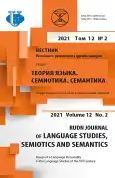Do Communicants Transmit Information in Course of Speech Communication?
- Autores: Tarasov E.F.1,2
-
Afiliações:
- The Institute of Linguistics, Russian Academy of Sciences
- Autonomous Non-commercial Organisation of Higher Education “Russian New University” (RosNOU)
- Edição: Volume 12, Nº 2 (2021): Image of a Language Personality in the Language Studies of the XXI Century
- Páginas: 255-268
- Seção: LANGUAGE PERSONALITY
- URL: https://journal-vniispk.ru/2313-2299/article/view/323376
- DOI: https://doi.org/10.22363/2313-2299-2021-12-2-255-268
- ID: 323376
Citar
Texto integral
Resumo
The article questions if human speech communication (SC) involves “a transfer of information”. The information functioning in speech communication is dwelled upon in the information and systemic activity approaches. The informational approach adequately explains only the direct method of information transfer, while the systemic activity approach is relevant for the sign-mediated speech communication typical for human interaction. The more heuristic thesis is that the perception of the chain of linguistic sign bodies produced in the intersubjective space only starts the construction of the perceived speech message content by the recipient. The completeness of the constructed speech message content depends entirely on the recipient, who has the optimal common consciousness with the speaker. The purpose of speech messages is not the actual construction of the content by the recipient, but the development of the message personal meaning. In human speech communication, the communicants do not transmit information, but use verbal signs bodies to actualize images of consciousness which are developed within a single ethnic culture and therefore are common for them. The incentive for the common consciousness development by the communicants is their participation in joint activities that ensure their earthly existence.
Sobre autores
Evgenij Tarasov
The Institute of Linguistics, Russian Academy of Sciences; Autonomous Non-commercial Organisation of Higher Education “Russian New University” (RosNOU)
Autor responsável pela correspondência
Email: eft35@mail.ru
Código SPIN: 3606-3220
Doctor in Philology, Professor, Head of the Department of psycholinguistics, The Institute of Linguistics, Russian Academy of Sciences, Moscow; Professor of the Department of Linguistics and Intercultural Communication of Russian New University (RosNOU)
1/1, B. Kislovskiy per., Moscow, Russian Federation, 125009; 22 Radio St., Moscow, Russian Federation, 105005Bibliografia
- Shennon, K. (1963). Works on information theory and cybernetics. Moscow: IL. (In Russ.).
- Wiener, N. (1958). Cybernetics and Society. Moscow: IL. (In Russ.).
- Brillouin, L. (1960). Science and Information Theory. Moscow: State publishing house. (In Russ.).
- Leontiev, A.N. (2012). Activity. Consciousness. Personality. Moscow: Kniga. (In Russ.).
- Chertov, L.F. (1993). Signity: the experience of theoretical synthesis of ideas about the sign method of information communication. Saint Petersburg: Publishing House of Saint Petersburg University. (In Russ.).
- Tarasov, E.F. (2020). To the problem of the common consciousness of communicants. Tula Scientific Bulletin. Series: History, Linguistics. Online edition, 4 (4), 128—135. (In Russ.).
- Vygotsky, L.S. (1982). Thinking and speech In Collected works: In 6 volumes. Vol. 2 Problems of general psychology, V.V. Davydov (Ed.). Moscow: Pedagogika. (In Russ.).
- Gostev, A.A. (2007). Psychology of secondary images. Moscow: Institute of Psychology RAS. (In Russ.).
Arquivos suplementares









